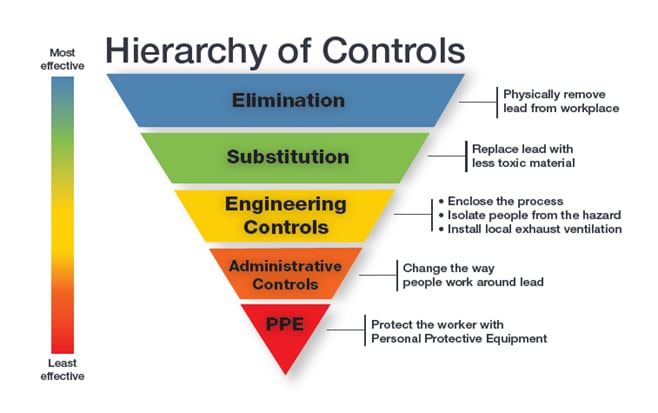Lead
Information For Employers
Workplace exposure limits are meant to protect workers from hazardous exposures in the workplace. Exposure limits incorporate safety margins to ensure that workers won’t be overexposed to hazardous chemicals or materials. Employers must ensure exposure limits are not exceeded.
NIOSH Recommended Exposure Limit (REL)
A time-weighted average (TWA) of 50 micrograms per cubic meter of air (50 µg/m3) over an 8-hour workshift.
OSHA Permissible Exposure Limit (PEL)
- OSHA’s PEL states lead exposure cannot be greater than 50 µg/m3 as a TWA over an 8-hour workshift.
- If working shifts longer than 8 hours, the exposure limit is reduced depending on the number of hours worked using the equation PEL = 400/hours worked.
For example,
The PEL for a 10-hour workshift (400/10) would be 40 µg/m3
The PEL for a 12-hour workshift: (400/12) would be 33.3 µg/m3
The Action Level for lead in general industry and the construction industry is a TWA of 30 µg/m3 over an 8-hour workshift. At this level, an employer must begin specific compliance activities, including blood lead level testing for exposed workers. OSHA’s lead standards also include medical surveillance, exposure monitoring, and hygiene facilities and practices that are critical in preventing lead exposure and elevated blood lead levels.
OSHA Lead Standards
Employers must keep SDSs for each chemical used in the workplace. SDSs can be acquired from the chemical manufacturer. Learn more about the format and contents of Safety Data Sheets.
Employers and safety professionals should examine the work area and task(s) workers perform to determine if work materials and equipment contain lead. Review Safety Data Sheets or test to determine if lead is present. If lead is present, use the hierarchy of controls to figure out the most effective way(s) to control exposures.
The following steps in the hierarchy of controls are listed in order of the most effective to least effective ways to reduce lead exposure:

Image by NIOSH
- Eliminate the lead source (physically remove the lead source from the workplace). Where possible, remove lead-containing materials or equipment from the process.
- Substitute the lead source with a material that is less toxic or has a lower lead content. For example, use lead-free bullets in place of leaded bullets or lead-free solder if it is not possible to remove the source completely.
- Engineering Controls ensure that the work area or equipment is designed to keep lead away from the worker. Examples include enclosing or isolating the lead emission source or using local exhaust ventilation to draw airborne lead away from the employee’s work area. For engineering controls to be effective, the control must be maintained and operated properly.
- Administrative Controls modify the way people work.
-
- Hand washing with soap and water is not effective at removing lead residue from hands.
NIOSH researchers developed wipes that remove 90% of lead residues from skin. Learn more about partnering with NIOSH to license this technology.
NIOSH researchers also developed a quick and easy hand wipe technology to let workers know instantly if they have lead on their hands.
Search “lead wipes” in any browser for a list of NIOSH-licensed, commercially available products that are proven to decontaminate your skin.
Establish standard operating procedures for tasks that would expose workers to lead.
- Implement strict housekeeping practices to minimize lead dust getting into the air and contaminating surfaces (e.g., using HEPA vacuums or wet sweeping methods, no dry sweeping).
- Provide employee training on hazards and safe work practices when working with lead.
- Direct employees to follow good hygiene practices. Use lead-removal products, wash hands, shower, and prevent contaminated work clothing and equipment from being taken home. These practices can reduce potential lead exposures and take-home lead, which also puts worker’s families at risk.
- Personal Protective Equipment (PPE) should be provided to workers if the other controls methods are insufficient or while better control methods are being implemented.
-
- PPE may include eye protection, gloves, boots, coveralls, and respiratory protection.
- Employers should also provide methods to clean or dispose of contaminated PPE.
If you are concerned that your employees are being exposed to lead or another workplace hazard, contact the NIOSH Health Hazard Evaluation Program and submit a request to have your work environment evaluated for free.
You may also contact the OSHA Consultation Program, a free consultation service funded by OSHA to find out about potential hazards at your worksites and improve your occupational safety and health management systems: OSHA Fact Sheet: The OSHA Consultation Program (PDF 49KB, 2 pages)
- Refer to OSHA Lead Standards for actions required to ensure your workers are safe.
- Contact your state OSHA office to see if your state has additional requirements.
If your employees are exposed to lead above the OSHA action level (time-weighted average of 30 µg/m3 over an 8-hour work shift), you are required to comply with applicable OSHA standards. This includes performing air monitoring, medical surveillance, biological monitoring (blood lead level testing), and other requirements.
